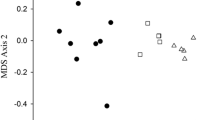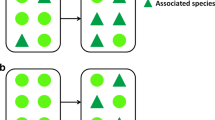Abstract
Stand diversification is considered a promising management approach to increasing the multifunctionality and ecological stability of forests. However, how tree diversity affects higher trophic levels and their role in regulating forest functioning is not well explored particularly for (sub)tropical regions. We analyzed the effects of tree species richness, community composition, and functional diversity on the abundance, species richness, and beta diversity of important functional groups of herbivores and predators in a large-scale forest biodiversity experiment in south-east China. Tree species richness promoted the abundance, but not the species richness, of the dominant, generalist herbivores (especially, adult leaf chewers), probably through diet mixing effects. In contrast, tree richness did not affect the abundance of more specialized herbivores (larval leaf chewers, sap suckers) or predators (web and hunting spiders), and only increased the species richness of larval chewers. Leaf chemical diversity was unrelated to the arthropod data, and leaf morphological diversity only positively affected oligophagous herbivore and hunting spider abundance. However, richness and abundance of all arthropods showed relationships with community-weighted leaf trait means (CWM). The effects of trait diversity and CWMs probably reflect specific nutritional or habitat requirements. This is supported by the strong effects of tree species composition and CWMs on herbivore and spider beta diversity. Although specialized herbivores are generally assumed to determine herbivore effects in species-rich forests, our study suggests that generalist herbivores can be crucial for trophic interactions. Our results indicate that promoting pest control through stand diversification might require a stronger focus on identifying the best-performing tree species mixtures.



Similar content being viewed by others
References
Abdala-Roberts L, Mooney KA, Quijano-Medina T, Campos-Navarrete MJ, González-Moreno A, Parra-Tabla V (2015) Comparison of tree genotypic diversity and species diversity effects on different guilds of insect herbivores. Oikos 124:1527–1535
Bagchi R, Gallery RE, Gripenberg S, Gurr SJ, Narayan L, Addis CE, Freckleton RP, Lewis OT (2014) Pathogens and insect herbivores drive rainforest plant diversity and composition. Nature 506:85–88
Baselga A (2010) Partitioning the turnover and nestedness components of beta diversity. Global Ecol Biogeogr 19:134–143
Bernays EA, Bright KL, Gonzalez N, Angel J (1994) Dietary mixing in a generalist herbivore: tests of two hypotheses. Ecology 75:1997–2006
Boege K, Barton KE, Dirzo R (2011) Influence of tree ontogeny on plant–herbivore interactions. In: Meinzer FC, Lachenbruch B, Dawson TE (eds) Size-and age-related changes in tree structure and function. Springer, Dordrecht, pp 193–214
Brown VK (1985) Insect herbivores and plant succession. Oikos 44:17–22
Bruelheide H et al (2014) Designing forest biodiversity experiments: general considerations illustrated by a new large experiment in subtropical China. Methods Ecol Evol 5:74–89
Campos RI, Vasconcelos HL, Ribeiro SP, Neves FS, Soares JP (2006) Relationship between tree size and insect assemblages associated with Anadenanthera macrocarpa. Ecography 29:442–450
Castagneyrol B, Jactel H (2012) Unraveling plant–animal diversity relationships: a meta-regression analysis. Ecology 93:2115–2124
Castagneyrol B, Jactel H, Vacher C, Brockerhoff EG (2014) Effects of plant phylogenetic diversity on herbivory depend on herbivore specialization. J Appl Ecol 51:134–141
Coley PD, Barone JA (1996) Herbivory and plant defenses in tropical forests. Annu Rev Ecol Syst 27:305–335
Dormann CF, Fründ J, Blüthgen N, Gruber B (2009) Indices, graphs and null models: analyzing bipartite ecological networks. Open Ecol J 2:7–24
Eichenberg D, Purschke O, Ristok C, Wessjohann L, Bruelheide H (2015) Trade-offs between physical and chemical carbon-based leaf defence: of intraspecific variation and trait evolution. J Ecol 103:1667–1679
Forister ML et al (2015) The global distribution of diet breadth in insect herbivores. Proc Natl Acad Sci USA 112:442–447
Garnier E et al (2004) Plant functional markers capture ecosystem properties during secondary succession. Ecology 85:2630–2637
Haddad NM, Crutsinger GM, Gross K, Haarstad J, Knops JMH, Tilman D (2009) Plant species loss decreases arthropod diversity and shifts trophic structure. Ecol Lett 12:1029–1039
Hebert PDN, Cywinska A, Ball SL, deWaard JR (2003) Biological identifications through DNA barcodes. Proc R Soc B 270:313–321
Jactel H, Brockerhoff EG (2007) Tree diversity reduces herbivory by forest insects. Ecol Lett 10:835–848
Janssen A, Sabelis MW, Magalhães S, Montserrat M, Van der Hammen T (2007) Habitat structure affects intraguild predation. Ecology 88:2713–2719
Jocqué R, Dippenaar-Schoeman AS (2007) Spider families of the world. Royal Museum for Central Africa, Tervuren
Josephrajkumar A, Rajan P, Mohan C, Thomas RJ (2011) First record of Asian grey weevil (Myllocerus undatus) on coconut from Kerala, India. Phytoparasitica 39:63–65
Karban R, Karban C, Huntzinger M, Pearse I, Crutsinger G (2010) Diet mixing enhances the performance of a generalist caterpillar, Platyprepia virginalis. Ecol Entomol 35:92–99
Kröber W, Zhang S, Ehmig M, Bruelheide H (2014) Linking xylem hydraulic conductivity and vulnerability to the leaf economics spectrum—a cross-species study of 39 evergreen and deciduous broadleaved subtropical tree species. PLoS One 9:e109211
Lefcheck JS, Whalen MA, Davenport TM, Stone JP, Duffy JE (2013) Physiological effects of diet mixing on consumer fitness: a meta-analysis. Ecology 94:565–572
Letourneau DK, Jedlicka JA, Bothwell SG, Moreno CR (2009) Effects of natural enemy biodiversity on the suppression of arthropod herbivores in terrestrial ecosystems. Annu Rev Ecol Evol Syst 40:573–592
Li Y, Härdtle W, Bruelheide H, Nadrowski K, Scholten T, von Wehrden H, von Oheimb G (2014) Site and neighborhood effects on growth of tree saplings in subtropical plantations (China). Forest Ecol Manag 327:118–127
Meyfroidt P, Rudel TK, Lambin EF (2010) Forest transitions, trade, and the global displacement of land use. Proc Natl Acad Sci USA 107:20917–20922
Moreira X, Abdala-Roberts L, Rasmann S, Castagneyrol B, Mooney KA (2016) Plant diversity effects on insect herbivores and their natural enemies: current thinking, recent findings, and future directions. Curr Opin Insect Sci 14:1–7
Muiruri EW, Rainio K, Koricheva J (2016) Do birds see the forest for the trees? Scale-dependent effects of tree diversity on avian predation of artificial larvae. Oecologia 180:619–630
Nadrowski K, Wirth C, Scherer-Lorenzen M (2010) Is forest diversity driving ecosystem functioning and service? Curr Opin Environ Sus 2:75–79
Nakagawa S, Schielzeth H (2013) A general and simple method for obtaining R 2 from generalized linear mixed-effects models. Methods Ecol Evol 4:133–142
Novotny V et al (2010) Guild-specific patterns of species richness and host specialization in plant-herbivore food webs from a tropical forest. J Anim Ecol 79:1193–1203
Pellissier L, Ndiribe C, Dubuis A, Pradervand J-N, Salamin N, Guisan A, Rasmann S (2013) Turnover of plant lineages shapes herbivore phylogenetic beta diversity along ecological gradients. Ecol Lett 16:600–608
Perez-Harguindeguy N, Diaz S, Vendramini F, Cornelissen JHC, Gurvich DE, Cabido M (2003) Leaf traits and herbivore selection in the field and in cafeteria experiments. Austral Ecol 28:642–650
Pérez-Harguindeguy N et al (2013) New handbook for standardised measurement of plant functional traits worldwide. Austral J Bot 61:167–234
Pfisterer AB, Diemer M, Schmid B (2003) Dietary shift and lowered biomass gain of a generalist herbivore in species-poor experimental plant communities. Oecologia 135:234–241
Plath M, Dorn S, Riedel J, Barrios H, Mody K (2012) Associational resistance and associational susceptibility: specialist herbivores show contrasting responses to tree stand diversification. Oecologia 169:477–487
Poorter L et al (2015) Diversity enhances carbon storage in tropical forests. Global Ecol Biogeogr 24:1314–1328
Quinn GP, Keough MJ (2002) Experimental design and data analysis for biologists. University Press, Cambridge
Rao CR (1982) Diversity and dissimilarity coefficients: a unified approach. Theor Popul Biol 21:24–43
Root RB (1973) Organization of a plant-arthropod association in simple and diverse habitats: the fauna of collards (Brassica oleracea). Ecol Monogr 43:95–124
Scherber C et al (2010) Bottom-up effects of plant diversity on multitrophic interactions in a biodiversity experiment. Nature 468:553–556
Scherer-Lorenzen M (2014) The functional role of biodiversity in the context of global change. In: Burslem D, Coomes D, Simonson W (eds) Forests and global change. Cambridge University Press, Cambridge, pp 195–238
Schowalter TD (2012) Insect herbivore effects on forest ecosystem services. J Sustain For 31:518–536
Schuldt A, Scherer-Lorenzen M (2014) Non-native tree species (Pseudotsuga menziesii) strongly decreases predator biomass and abundance in mixed-species plantations of a tree diversity experiment. Forest Ecol Manag 327:10–17
Schuldt A, Staab M (2015) Tree species richness strengthens relationships between ants and the functional composition of spider assemblages in a highly diverse forest. Biotropica 47:339–346
Schuldt A et al (2010) Tree diversity promotes insect herbivory in subtropical forests of south-east China. J Ecol 98:917–926
Schuldt A, Both S, Bruelheide H, Härdtle W, Schmid B, Zhou H, Assmann T (2011) Predator diversity and abundance provide little support for the enemies hypothesis in forests of high tree diversity. PLoS One 6:e22905
Schuldt A, Assmann T, Bruelheide H, Durka W, Eichenberg D, Härdtle W, Kröber W, Michalski SG, Purschke O (2014a) Functional and phylogenetic diversity of woody plants drive herbivory in a highly diverse forest. New Phytol 202:864–873
Schuldt A, Baruffol M, Bruelheide H, Chen S, Chi X, Wall M, Assmann T (2014b) Woody plant phylogenetic diversity mediates bottom-up control of arthropod biomass in species-rich forests. Oecologia 176:171–182
Schuldt A, Bruelheide H, Härdtle W, Assmann T, Li Y, Ma K, von Oheimb G, Zhang J (2015a) Early positive effects of tree species richness on herbivory in a large-scale forest biodiversity experiment influence tree growth. J Ecol 103:563–571
Schuldt A et al (2015b) Multitrophic diversity in a biodiverse forest is highly nonlinear across spatial scales. Nat Commun 6:10169. doi:10.11038/ncomms10169
Seidl R, Schelhaas M-J, Rammer W, Verkerk PJ (2014) Increasing forest disturbances in Europe and their impact on carbon storage. Nat Clim Change 4:806–810
Sobek S, Scherber C, Steffan-Dewenter I, Tscharntke T (2009a) Sapling herbivory, invertebrate herbivores and predators across a natural tree diversity gradient in Germany’s largest connected deciduous forest. Oecologia 160:279–288
Sobek S, Steffan-Dewenter I, Scherber C, Tscharntke T (2009b) Spatiotemporal changes of beetle communities across a tree diversity gradient. Divers Distrib 15:660–670
Srivastava DS, Lawton JH (1998) Why more productive sites have more species: an experimental test of theory using tree-hole communities. Am Nat 152:510–529
Staab M, Schuldt A, Assmann T, Klein AM (2014) Tree diversity promotes predator but not omnivore ants in a subtropical Chinese forest. Ecol Entomol 39:637–647
Strong DR, Lawton JH, Southwood TRE (1984) Insects on plants: community patterns and mechanisms. Blackwell, Oxford
Terborgh J (2012) Enemies maintain hyperdiverse tropical forests. Am Nat 179:303–314
Vehviläinen H, Koricheva J, Ruohomaki K (2007) Tree species diversity influences herbivore abundance and damage: meta-analysis of long-term forest experiments. Oecologia 152:287–298
Vehviläinen H, Koricheva J, Ruohomaki K (2008) Effects of stand tree species composition and diversity on abundance of predatory arthropods. Oikos 117:935–943
Verheyen K et al (2016) Contributions of a global network of tree diversity experiments to sustainable forest plantations. Ambio 45:29–41
Yang X et al (2013) Establishment success in a forest biodiversity and ecosystem functioning experiment in subtropical China (BEF-China). Eur J Forest Res 132:593–606
Zhang YA, Adams J (2011) Top-down control of herbivores varies with ecosystem types. J Ecol 99:370–372
Acknowledgements
We thank the BEF-China consortium for support; Weibin Zhu, Chaodong Zhu, Zhisheng Zhang, Bo Yang, and Weiwei Zhang for help with arthropod sampling and identification; and two anonymous reviewers and the Editor for constructive comments. Ying Li, Goddert von Oheimb, and Werner Härdtle kindly provided tree height data. We gratefully acknowledge funding by the German Research Foundation (DFG FOR 891/1 and 891/2), the Sino-German Centre for Research Promotion in Beijing (GZ 524, 592, 698, 699, 785, 970 and 1020), and the National Natural Science Foundation of China (No. 31370042).
Author contribution statement
JZ and AS designed the study. JZ, XC, XX, LX, HB, DE, and WK collected and prepared the data. AS analyzed the data. AS and JZ wrote the manuscript, with input from all coauthors.
Author information
Authors and Affiliations
Corresponding author
Additional information
Communicated by Andreas Prinzing.
Electronic supplementary material
Below is the link to the electronic supplementary material.
Rights and permissions
About this article
Cite this article
Zhang, J., Bruelheide, H., Chen, X. et al. Tree diversity promotes generalist herbivore community patterns in a young subtropical forest experiment. Oecologia 183, 455–467 (2017). https://doi.org/10.1007/s00442-016-3769-0
Received:
Accepted:
Published:
Issue Date:
DOI: https://doi.org/10.1007/s00442-016-3769-0




